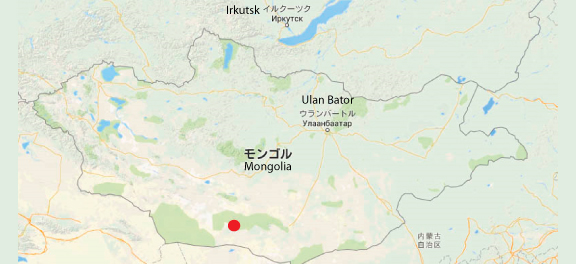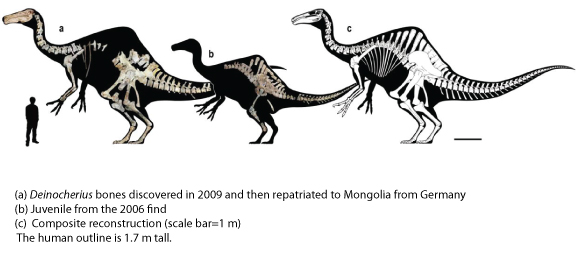Deinocheirus mirificus, no longer an enigma
Research Press Release | October 30, 2014
-
 Red dot marks location of where all Deinocheirus specimens were found.
Red dot marks location of where all Deinocheirus specimens were found. -
 Deinocheirus site in 2009
Deinocheirus site in 2009 -
 (a) Skull: left view; (b) Reconstruction of the skull (scale is 10cm)
(a) Skull: left view; (b) Reconstruction of the skull (scale is 10cm)
| Press Release | ||
|---|---|---|
| Key Points |
– Attaining the Society of Vertebrate Paleontology’s long-cherished desire to reveal Deinocheirus’s identity – Nobody expected how distinctive Deinocheirus is and it is a truly weird dinosaur never been found before. – This study provided the best example for how illegal specimens should be handled for science. |
|
| Background |
– Deinocheirus was found and collected by the 1965 Polish-Mongolian Palaeontological Expedition at Altan Uul III in the southern Gobi of Mongolia. Only two giant forelimbs (2.4 m length) with scapulocoracoids were found with small fragmentary bones. – Dr. Osmólska, a Polish paleontologist, studied and named it as Deinocheirus mirificus (meaning “horrible hand” “unusual”) in 1970. Why the mystery? – Paleontologists could not reveal Deinocheirus’s identity because no additional specimen has been found for almost 50 years since the first discovery. – Some people thought that Deinocheirus would be a humongous theropod dinosaur that was much larger than Tyrannosaurus based on its giant forelimbs. – Up to date, Deinocheirus has remained one the most mysterious dinosaurs in the world. |
|
| Discoveries |
Discovery of new Deinocheirus – The first new specimen was discovered in the Nemegt Formation at Bugiin Tsav by members of the Korea-Mongolia International Dinosaur Expedition (KID) in 2009. KID expedition was sponsored to Dr. Yuong-Nam Lee in Korea Institute of Geoscience and Mineral Resources (KIGAM) by Hwaseong city, Korea from 2006 to 2011. – When found in August 16, 2009, many isolated bones and broken blocks containing bones were exposed in a large excavation, implying a poached quarry. A skull and feet were missing, but rest of the skeleton, including a left forelimb, clearly identifiable as Deinocheirus were collected and shipped to Korea for preparation and studying. – During preparation of Bugiin Tsav specimen, newly recognized unique features on the femoral head led to the recognition of another Deinocheirus in the KID collection. The second specimen, which had also been poached and lacked head, hands and feet, was collected at Altan Uul III in 2006. – Therefore, two new specimens of Deinocheirus were discovered in different localities. Bugiin Tsav specimen is 6% larger than holotype and Altan Uul specimen is a juvenile approximately 74% the size of the former. |
|
| On the Specimens |
Repatriation of poached materials – A skull, left hand, and the feet of Deinocheirus were found in a private collection in Europe in 2011. They had been collected in Mongolia and sold to an unknown buyer in Japan and subsequently sold to another party in Germany. – An isolated right pedal phalanx II-2 we collected in Bugiin Tsav fits perfectly into an impression in the matrix attached to pahlanx II-1 of the poached specimen, confirming the same individual. – These poached materials were repatriated to Mongolia on May 1st, 2014 by donation of the dealer. – It became possible to make a paper including all new materials of Deinocheirus available. – The manuscript titled “Long-standing enigmas of a giant ornithomimosaur Deinocheirus mirificus resolved” was submitted to Nature on Aug. 9th, 2014 and accepted on September 19th, 2014. Nature embargoed the article until Sept. 22, 1 PM ET. |
|
| Description |
Identity of Deinocheirus – Bugiin Tsav Deinocheirus had a body length 11 m and an estimated body weight of 6.4 metric ton. – The skull is very elongate with a duck-like spatulate beak and edentulous. – Very long neural spines are developed in dorsal and sacral vertebrae, almost attaining the highest ratio of Spinosaurus. – Each pedal ungual has a unique shape that has never been reported in any other theropod dinosaur, with the distal end bluntly truncated rather than tapered. It would have prevented its feet from sinking deep into wet substrates. – Robust hind limbs with posteroventrally tilted, wide hips, femora longer than tibiae, and massive feet clearly indicate that Deinocheirus was a slow mover. – Fish remains as stomach contents and a large number (> 1400) of gastroliths suggest that Deinocheirus was megaomnivorous. – Long forearms with giant claws may have been used for digging and gathering herbaceous plants in freshwater habitats. – Basal ornithomimosaurs separated into two lineages (Deinocheiridae and Ornithomimidae) in the Early Cretaceous. Deinocheirids followed a different evolutionary path from cursorial ornithomimids. Deinocheirids evolved into large forms by developing high degreed pneumatic system comparable with that of a sauropod. |
|
| Inquiries |
Yoshitsugu Kobayashi, Associate Professor, Hokkaido University Museum TEL: & FAX: +81-11-706-4730 E-mail: ykobayashi@museum.hokudai.ac.jp |
|
|
Japanese Link |
巨大オルニトミモサウルス類デイノケイルス・ミリフィクスの長年の謎を解決 | |
| Publications | Resolving the long-standing enigmas of a giant ornithomimosaur Deinocheirus mirificus (Nature, 2014.10.22) | |


